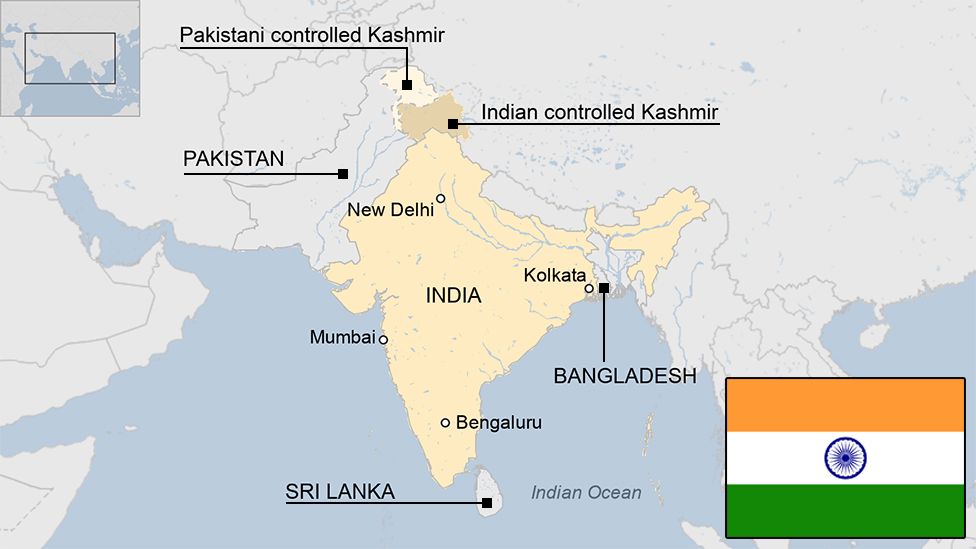India country profile
- Published

India is the world's largest democracy and, according to UN estimates, its population is expected to overtake China's in 2028 to become the world's most populous nation.
As a rising economic powerhouse and nuclear-armed state, India has emerged as an important regional power. But it is also tackling huge, social, economic and environmental problems.
Home to some of the world's most ancient surviving civilisations, the Indian subcontinent - from the mountainous Afghan frontier to the jungles of Burma and the coral reefs of the Indian Ocean - is both vast and varied in terms of people, language and cultural traditions.
- See more country profiles - Profiles compiled by BBC Monitoring
REPUBLIC OF INDIA: FACTS
- Capital: New Delhi
- Area: 3,287,263 sq km
- Population: 1.37 billion
- Languages: Hindi, English, plus local languages
- Life expectancy: 68 years (men) 71 years (women)
LEADERS
President: Droupadi Murmu
Droupadi Murmu was sworn in as president in July 2022. A teacher and former governor of Jharkhand State, she is the first person from a tribal community to serve as India's head of state. She is a member of the governing Bharatiya Janata Party. The presidency is largely ceremonial, but can play a significant role if, for example, no party wins an outright majority in elections.
Prime Minister: Narendra Modi
Hindu nationalist Narendra Modi stormed to power on a surge of popular expectation and anger at corruption and weak growth.
Despite Mr Modi's polarising image, his Bharatiya Janata Party (BJP) scored an unprecedented landslide victory in the May 2014 parliamentary elections.
It was the first time in 30 years that a single party had won a clear parliamentary majority.
Mr Modi fought on his record as chief minister of the economically successful state of Gujarat, promising to revitalise India's flagging economy.
But his time in Gujarat was overshadowed by accusations that he did too little to stop sectarian riots in 2001 that saw more than 1,000 people - mainly Muslims - killed.
KASHMIR
The Himalayan region of Kashmir has been a flashpoint between India and Pakistan for over six decades.
Since India's partition and the creation of Pakistan in 1947, the nuclear-armed neighbours have fought two wars over the Muslim-majority territory, which both claim in full but control in part.
Today it remains one of the most militarised zones in the world. China administers parts of the territory.
MEDIA
India has a burgeoning media industry, with broadcast, print and digital media experiencing tremendous growth.
There are around 197 million TV households, many of them using satellite or cable. FM radio stations are plentiful but only public All India Radio can produce news.
The press scene is lively with thousands of titles. India has the second largest number of internet users in the world, after China.
TIMELINE
Some key dates in India's history:
2500 BC - India is home to several ancient civilisations and empires.
1600s - The British arrive and establish trading posts under The British East India Company - by the 1850s they control most of the subcontinent.
1858 - India comes under direct British rule.
1920 - Nationalist leader Mahatma Gandhi heads a campaign of non-violent protest against British rule which eventually leads to independence.
1947 - India is split into two nations at independence - Hindu-majority India and Muslim-majority Pakistan.
1971 - India and Pakistan go to war over East Pakistan, leading to the creation of Bangladesh.
1974 - India conducts its first underground nuclear test.
1990s - Government initiates a programme of economic liberalisation and reform, opening up the economy to global trade and investment.
2014 - Hindu nationalist BJP party scores biggest election victory by any party in 30 years.
Related Topics
- Published15 March
- Published19 December 2023
- Published25 August 2023
- Published21 March 2023
- Published21 March 2023
- Published26 May 2023
- Published8 January
- Published20 March 2023
- Published16 October 2023